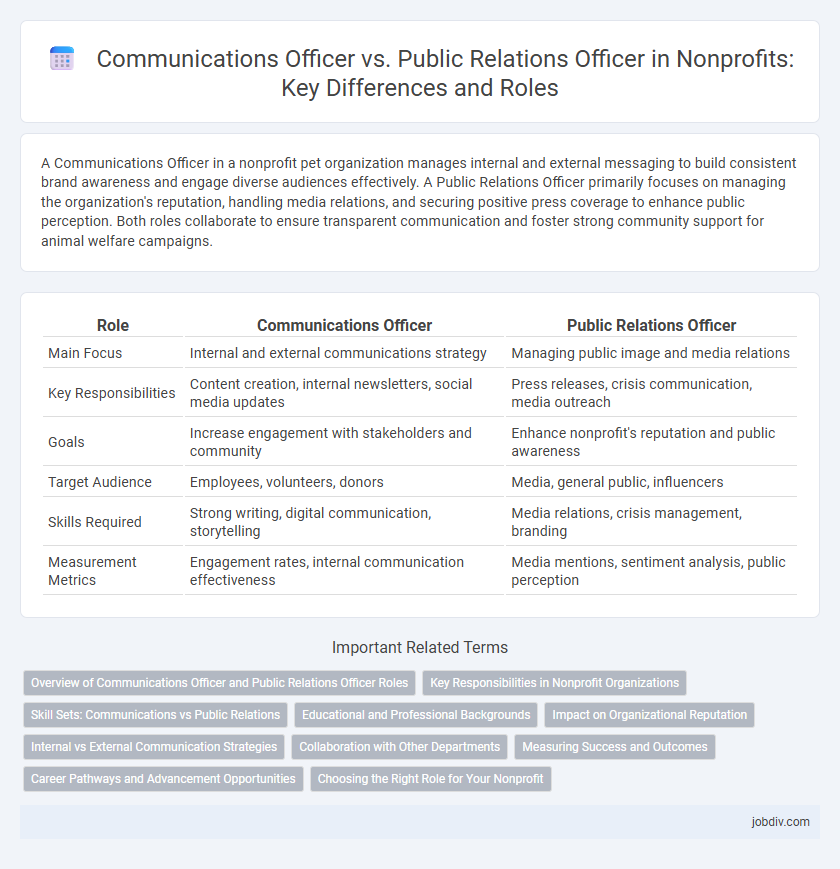A Communications Officer in a nonprofit pet organization manages internal and external messaging to build consistent brand awareness and engage diverse audiences effectively. A Public Relations Officer primarily focuses on managing the organization's reputation, handling media relations, and securing positive press coverage to enhance public perception. Both roles collaborate to ensure transparent communication and foster strong community support for animal welfare campaigns.
Table of Comparison
| Role | Communications Officer | Public Relations Officer |
|---|---|---|
| Main Focus | Internal and external communications strategy | Managing public image and media relations |
| Key Responsibilities | Content creation, internal newsletters, social media updates | Press releases, crisis communication, media outreach |
| Goals | Increase engagement with stakeholders and community | Enhance nonprofit's reputation and public awareness |
| Target Audience | Employees, volunteers, donors | Media, general public, influencers |
| Skills Required | Strong writing, digital communication, storytelling | Media relations, crisis management, branding |
| Measurement Metrics | Engagement rates, internal communication effectiveness | Media mentions, sentiment analysis, public perception |
Overview of Communications Officer and Public Relations Officer Roles
Communications Officers in nonprofit organizations focus on managing internal and external messaging, developing content strategies, and ensuring consistent communication across platforms to support the organization's mission. Public Relations Officers primarily handle media relations, reputation management, and community engagement to enhance the nonprofit's public image. Both roles require strong storytelling skills, but Communications Officers emphasize comprehensive communication plans while Public Relations Officers concentrate on maintaining positive public perception.
Key Responsibilities in Nonprofit Organizations
Communications Officers in nonprofit organizations manage internal and external messaging, develop content strategies, and oversee digital platforms to ensure consistent brand voice and stakeholder engagement. Public Relations Officers focus on building and maintaining the organization's reputation through media relations, press releases, and event coordination to enhance public awareness and support. Both roles collaborate to align communication efforts with the nonprofit's mission, but Communications Officers emphasize information dissemination while Public Relations Officers prioritize reputation and relationship management.
Skill Sets: Communications vs Public Relations
Communications Officers excel in crafting clear, consistent messaging across internal and external channels, utilizing skills in content creation, digital media management, and stakeholder engagement to support organizational goals. Public Relations Officers specialize in building and maintaining a positive public image through media relations, crisis communication, and strategic reputation management, leveraging expertise in press releases, event coordination, and influencer partnerships. Both roles require strong writing and interpersonal skills, but Communications Officers prioritize message coherence and audience targeting, while Public Relations Officers focus on media outreach and brand perception.
Educational and Professional Backgrounds
Communications Officers in nonprofits typically hold degrees in communications, journalism, or marketing, combined with experience in content creation, digital media, and stakeholder engagement. Public Relations Officers often possess educational backgrounds in public relations, corporate communications, or public affairs, emphasizing skills in media relations, crisis communication, and brand reputation management. Professional certifications like the Accredited in Public Relations (APR) credential can enhance qualifications for both roles in nonprofit settings.
Impact on Organizational Reputation
Communications Officers shape organizational reputation by managing internal and external messaging, ensuring consistency across all communication channels, which builds trust and engagement with stakeholders. Public Relations Officers focus on enhancing public perception through strategic media relations, crisis management, and event coordination, directly influencing how the nonprofit is viewed by the broader community. Both roles are critical for reputation management, with Communications Officers fostering ongoing stakeholder dialogue and Public Relations Officers driving targeted reputation campaigns.
Internal vs External Communication Strategies
Communications Officers in nonprofits primarily manage internal communication strategies, fostering clear information flow between staff, volunteers, and board members to ensure alignment with organizational goals. Public Relations Officers focus on external communication strategies, enhancing the nonprofit's public image through media relations, community outreach, and stakeholder engagement. Both roles are essential for nonprofit success, balancing internal cohesion with positive external visibility.
Collaboration with Other Departments
Communications Officers in nonprofits collaborate closely with program and development teams to ensure aligned messaging and support fundraising efforts, while Public Relations Officers coordinate primarily with external media and stakeholders to shape the organization's public image. Effective teamwork between these roles facilitates consistent narratives across internal and external channels, enhancing overall organizational impact. Cross-departmental collaboration is essential for maintaining brand integrity and amplifying advocacy campaigns.
Measuring Success and Outcomes
Communications Officers measure success through engagement metrics such as website traffic, email open rates, and social media interactions, focusing on content reach and audience feedback. Public Relations Officers evaluate outcomes by tracking media coverage quality, press release pick-up, and shifts in public perception or stakeholder sentiment. Both roles utilize analytics tools and surveys to assess impact, but Communications Officers emphasize direct audience engagement while Public Relations Officers prioritize reputation management and external visibility.
Career Pathways and Advancement Opportunities
Communications Officers in nonprofits focus on internal and external messaging, mastering content creation, social media strategies, and stakeholder engagement to build a cohesive brand presence. Public Relations Officers specialize in managing the organization's reputation, media relations, crisis communications, and event planning to enhance public perception and visibility. Career advancement for Communications Officers often leads to roles like Communications Director or Chief Communications Officer, while Public Relations Officers may progress to senior PR management, Director of Public Affairs, or Chief Marketing Officer positions.
Choosing the Right Role for Your Nonprofit
A Communications Officer in a nonprofit oversees internal and external messaging, ensuring consistent brand voice and managing digital content, while a Public Relations Officer primarily focuses on building and maintaining a positive public image through media relations and event coordination. Choosing the right role depends on your nonprofit's strategic priorities: prioritize a Communications Officer to strengthen ongoing stakeholder engagement and content strategy, or opt for a Public Relations Officer to enhance visibility and manage crisis communications. Assess your organization's goals, audience needs, and resource allocation to align the role with your mission-driven communication objectives.
Communications Officer vs Public Relations Officer Infographic

 jobdiv.com
jobdiv.com